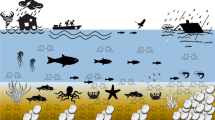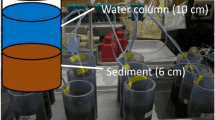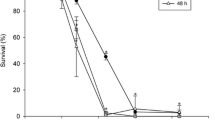Abstract
The experiment was designed to determine the effect of suspended clay sediments on the bioconcentration of the chlorinated hydrocarbon pesticide Kelthane® (dicofol, 4-chloro-α-(4-chlorophenyl)-α-(trichloromethyl) benzene methanol) in fathead minnowsPimephales promelas). The test was carried out under continuous-flow conditions with a modified Mount-Brungs toxicant dilution apparatus and an exposure period of 28 days. Two known safe Kelthane® treatment levels were tested in both filtered lake water and lake water containing approximately 65 mg/L of clay particles. The clay sediments decreased bioconcentration in fathead minnows by 35%, indicating that the 30 + % of total Kelthane® sorbed onto clay was biologically unavailable to the fish. Bioconcentration factors at the two Kelthane® concentrations were not significantly different. Steady-state concentrations were estimated to occur in 39 to 60 days of exposure at 9,500 to 18,900 times water levels.
Similar content being viewed by others

References
American Public Health Association: Standard methods for the examination of water and wastewater. 14 ed. New York:American Public Health Association (1974).
American Society for Testing and Materials: Proposed standard practice for conducting bioconcentration tests with fishes and saltwater bivalve molluscs. Draft manuscript #3, June 10, Duluth, Minnesota (1981).
Benoit, D. A., and F. A. Puglisi: A simplified flow-splitting chamber and siphon for proportional diluters. Water Res.7, 1915 (1973).
Brungs, W. A., and G. W. Bailey: Influence of suspended solids on the acute toxicity of endrin to fathead minnows. Proc. 21st. Purdue Indust. Waste Conf., Lafayette, Part I, 50, 4 (1967).
Chiou, C. T., V. H. Freed, D. W. Schmeeding, and R. L. Kohnert: Partition coefficient and bioconcentration of selected organic chemicals. Environ. Sci. Technol.11, 475 (1977).
Chiou, C. T., L. J. Peters, and V. H. Freed: A physical concept of soil-water equilibria for non-ionic organic compounds. Science206, 831 (1979).
Committee on Methods for Toxicity Tests with Aquatic Organisms: Methods for acute toxicity tests with fish, macroinvertebrates, and amphibians. U.S. Environmental Protection Agency, Duluth, MN EPA-660/3-75-009 (1975).
Ferguson, D. E., J. L. Ludke, J. P. Wood, and J. W. Prather: The effects of mud on the bioactivity of pesticides on fishes. J. Mississippi Acad. Sci.11, 219 (1965).
Halter, M. T., and H. E. Johnson: A model system to study the desorption and biological availability of PCB in hydrosoils. In F. L. Mayer, and J. F. Hamelink (eds.): Aquatic toxicology and hazard assessment, p. 178, ASTM, STP 634. Philadelphia: American Society for Testing and Materials (1976).
Hansch, C., and A. J. Leo: Substituent constants for correlation analysis in chemistry and biology. New York: John Wiley & Sons (1979).
Holcombe, G. W., G. L. Phipps, and D. K. Tanner: The acute toxicity of Kelthane®, Dursban®, disulfoton, pydrin, and permethrin to fathead minnows (Pimephales promelas) and rainbow trout (Salmo gairdneri). Environ. Pollut. (Series A)29, 167 (1982).
Jackson, M. F.: Soil chemical analysis—advanced course. Monograph 115, Chapter 3, p. 101. College of Agriculture, Dept. of Soils, University of Wisconsin, Madison. (1956).
Kenaga, E. E.: Predicted bioconcentration factors and soil sorption coefficients of pesticides and other chemicals. Ecotoxicol. Environ. Safety4, 26 (1980).
Kenaga, E. E., and C. A. I. Goring: Relationship between water solubility, soil sorption, octanol-water partitioning, and concentration of chemicals in biota. In J. G. Eaton, P. R. Parrish, and A. C. Hendricks (eds.): Aquatic toxicology, p. 78, ASTM, STP 707. Philadelphia: American Society for Testing and Materials (1980).
Lockhart, W. L.: Methoxychlor studies with fish: Athabaska River exposures and experimental exposures. In W. O. Haufe, and G. C. R. Croome (eds.): Control of black flies in the Athabaska River, p. 183. Edmonton: Technical Report Alberta Environment (1980).
Lynch, T. R., and H. E. Johnson: Availability of a hexachlorobiphenyl isomer to benthic amphipods from experimentally contaminated natural sediments. In J. G. Pearson, R. B. Foster, and W. E. Bishop (eds.): Aquatic toxicology and hazard assessment, p. 273, ASTM, STP 766. Philadelphia: American Society for Testing and Materials (1982).
Marklund, D., P. Morton, S. Kohlbry, and E. Ruenger: Results of analyses performed under EPA task plans NAARD0309 and NAARD0308. Lake Superior Basin Studies Center Manuscript, University of Minnesota-Duluth, November 1981.
Mount, D. I., and W. A. Brungs: A simplified dosing apparatus for toxicity studies. Water Res.1, 21 (1967).
Phipps, G. L., G. W. Holcombe, and J. T. Fiandt: A saturator system for generating toxic water solutions for toxicity tests. Prog. Fish-Cult.44, 115 (1982).
Sebastien, R. J., and W. L. Lockhart: The influence of formulation on toxicity and availability of a pesticide (methoxychlor) to black fly larvae (Diptera: Simuliidae), some nontarget insects and fish. Can. Entomol.13, 281 (1981).
Southworth, G. R., B. R. Parkhurst, and J. J. Beauchamp: Accumulation of acridine from water, food, and sediment by the fathead minnow,Pimephales promelas. Water, Air, and Soil Pollut.12, 331 (1979).
Spehar, R. L., D. K. Tanner, and J. H. Gibson: The effects of Kelthane® and pydrin on early life stages of fathead minnows (Pimephales promelas) and amphipods (Hyalella azteca). In J. G. Pearson, R. B. Foster, and W. E. Bishop (eds.): Aquatic toxicology and hazard assessment, p. 234, ASTM, STP 766. Philadelphia: American Society for Testing and Materials (1982).
Veith, G. D., and P. Kosian: Estimating bioconcentration potential from octanol/water partition coefficients. In D. Mackay, S. Paterson, S. J. Eisenreich, and M. S. Simmons (eds.): The physical behavior of PCBs in the Great Lakes, p. 269. Ann Arbor: Ann Arbor Science (1982).
Veith, G. D., D. L. DeFoe, and B. V. Bergstedt: Measuring and estimating the bioconcentration factor of chemicals in fish. J. Fish. Res. Board Can.36, 1040 (1979).
Author information
Authors and Affiliations
Rights and permissions
About this article
Cite this article
Eaton, J.G., Mattson, V.R., Mueller, L.H. et al. Effects of suspended clay on bioconcentration of Kelthane® in fathead minnows. Arch. Environ. Contam. Toxicol. 12, 439–445 (1983). https://doi.org/10.1007/BF01057587
Received:
Revised:
Issue Date:
DOI: https://doi.org/10.1007/BF01057587



